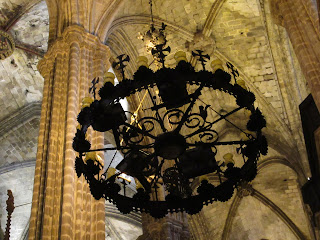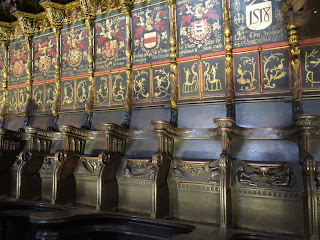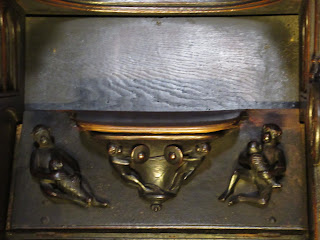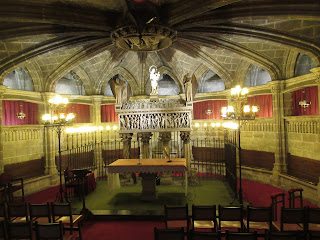Barcelona's Picasso Museum we had just visited had revealed a young genius on the verge of breakthrough. In the same way, Antonin Gaudi's Palau Guell, completed in 1890, showed the architect taking his first steps toward what would become his trademark curvy style. Having toured Gaudi's landmark site of Sagrada Familia, and then both his Park Guell and Casa Batllo, we'd had enough of all things Gaudi by then so only admired the outside of Palau Guell!
We headed next to Barcelona's 14th century, Gothic-style Cathedral of the Holy Cross and Saint Eulalia, which has played a significant role in the city’s history. Simply called the Cathedral, it has been the city’s holiest spot for 2,000 years. The Romans built their Temple of Jupiter here.
In 343 AD, the pagan temple was replaced with a Christian cathedral which was replaced again by a Romanesque-style church in the 11th century. The current Gothic structure was started in 1298 and finished in 1450, during the medieval glory days of the Catalan nation. A more ornate, central 230-foot tall central spire was added in 1913. The cathedral cost seven euros each for us to enter which I thought was an expensive place to come and admire God.
The nave had an astounding 28 chapels, most of them native saints who are honored on public holidays.
Beneath the crucifix was the bishop’s chair. As a cathedral,
the church is a bishop’s seat – therefore its Catalan nickname of La Seu.
To the left of the altar was the cathedral organ.
The wall to the right of the altar was decorated with Catalunya's yellow and red coat of arms.
On the backrests of the choir seats were commemorative shields corresponding to the Knights of the Golden Fleece.
The back of the choir had some magnificent stone reliefs.
Steps below the altar led to the crypt which featured the marble and alabaster sarcophagus containing the remains of the young Santa Eulalia (1327-1339) who died when she was just 13.
Near the back of the church was a side chapel with the 15th century baptismal font made of Carrara marble and carved in the shape of a goblet. The painting behind the font was a contemporary work showing the baptism of Christ. Like all the other chapels, it, too, was behind a wrought iron grille.
I read the font had helicoidal edges, a word I'd never heard before! I looked it up and discovered it meant coiled or curving like a spiral.
The side chapel of Christ or the Holy Christ of Lepanto contained a notable image of Christ which is one especially dear to Barcelonans. Fortunately, it was open to those who wanted to pay their respects.
A stunning arcaded walkway surrounded the lush circa 1450 Cloister
that looked like a tropical paradise with palm, orange and magnolia trees even
in the rain!
I read that during the Corpus Christi festival in June, kids come here to watch a hollow egg ‘dance’ atop the fountain’s spray!
The cloister's resident geese have been there for at least 500 years. There
have always been 13 geese, in memory of St. Eulalia’s 13 years and 13 torments which I wrote about in the first Barcelona post.
As we wandered the cloister, we could see the coats of arms and many tombs in the pavement. The latter were for rich merchants who paid good money to be buried as close to the altar as possible!
We could tell some of the merchants' professions by the symbols of their trade as in the boots here.
I paid special attention to the image of St. Bernadette in the Lourdes Chapel in the cloister as we’d be visiting that city in France in less than a week.
This was the third time we’d heard and see this woman performing for tips outside the Cathedral. I am no judge of voices but she sounded beautiful and had superb acoustics to match. Other people must have agreed because she attracted quite a crowd even in the miserable weather.
We didn’t want to leave Barcelona without seeing the interior of the Basilica de Santa Maria del Mar or the so-called Cathedral of the Sea that was built entirely with local funds and labor in the heart of the wealthy El Born quarter. The stone for the church was quarried at Montjuic and had to carried across town on the backs of porters.
Shortly after we arrived, an International Mass began which we stayed for. As the name would suggest, it was celebrated in several languages: Catalan, Spanish, French and English. I had never heard of such a Mass before and was glad we were able to spend part of our Sunday attending Mass so far away from home.
Though the church stands in the shadow of the nearby Barcelona Cathedral because of its size and being far less ornate, I still thought it lovely and appreciated that the locals considered the church the second-best sight in all of Barcelona, according to our walking tour guide from several days ago.
A statue of St. Ignatius:
Over the years, constant social and political turmoil have sadly caused destruction to the basilica. But nothing could compare to the destruction of July 19th, 1936, when Santa Maria del Mar was set on fire during the beginning of the Spanish Civil War. The basilica burned for eleven days. The baroque altar, the images, and the historical archives were all destroyed. Only the walls, columns, and a few stained-glass windows on the upper level survived. When restoration was done, they decided to keep the decor simpler and not replace the ornate altar to showcase the incredible Gothic architecture.
We walked on to Barcelona's port. There was obviously lots of dinero in this city with all the expensive yachts!
I couldn’t help but smile after spotting the floating sculptures created by Robert Llimosos!
The wooden pedestrian bridge that jutted straight out into harbor
was a modern extension of the Ramblas
we’d walked along, again on our first day. We had to wait on the drawbridge to
allow a boat to pass.
Beyond the bridge was the 200-foot column of the Columbus Monument.
The frilly, pale yellow building was the fanciful Modernista-style port authority building.
The monument honored Christopher Columbus who came to Barcelona in 1493 after traveling to America. Catalan’s answer to Nelson’s Column in London's Trafalgar Square, even down to the lions, was built for the 1888 Universal Exposition, an international fair that helped put Barcelona onto the world stage.
The base of the monument was ringed with four winged victories
meant to represent taking flight to the four corners of the earth. There were statues
and reliefs of mapmakers, navigators and even early explorers preaching to
subservient Native Americans!
Next post: Trying to decipher Catalunya.
Posted on December 2nd, 2018, from Seville, Spain.




















































































Despite the incredible pace you and Steven maintain during these travel adventures, your photos always capture huge smiles and contentment.. you savour each moment and share the highlights in your posts .. thanks for this one .. loved this "Anne- narrated" tour of the Cathedral and the Basilica. xo
ReplyDeleteLina,
ReplyDeleteNice to know you enjoyed reading about both the Basilica and the Cathedral - both interesting places but very different as you no doubt noticed.